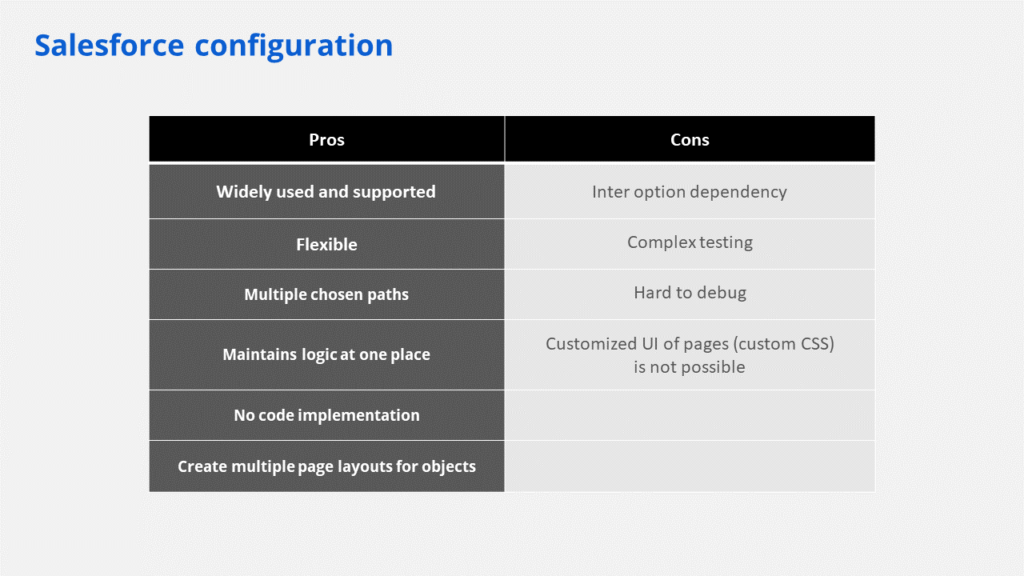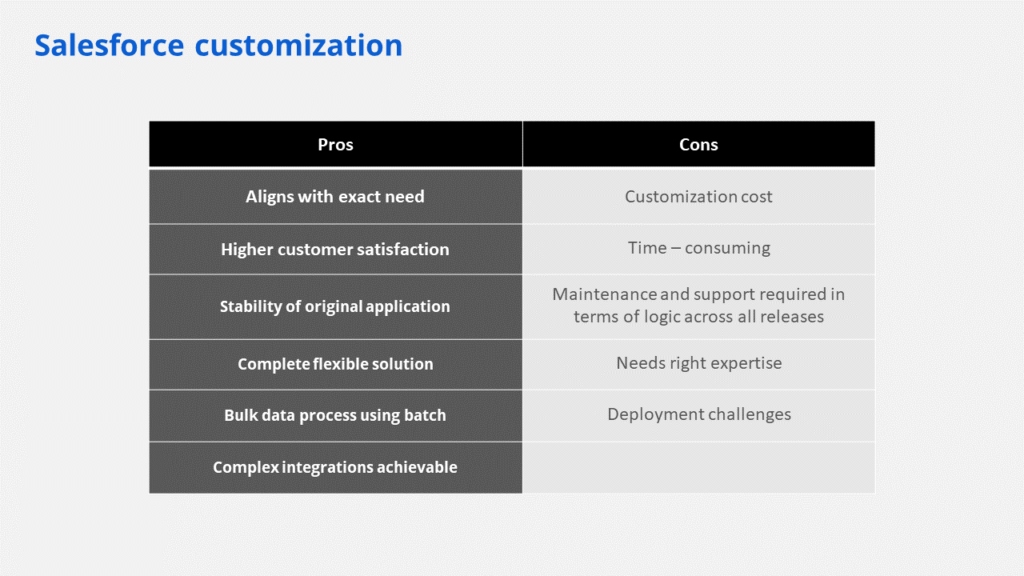Optimize Salesforce for the best value creation
A CRM is a key functional tool of any business, linking all the stakeholders in an organization — the employees, leaders, customers, prospects, and the organization itself and Salesforce is one of the most trusted CRMs globally, with an ecosystem of 10+ products, 150,000+ customers, and 1,800+ partners.
So what makes Salesforce such a popular CRM platform?
Primarily, Salesforce is widely adopted as it is highly configurable, customizable, robust, and flexible. However, every organization has its different operations and its own unique need and approach to use Salesforce. Therefore, Salesforce shouldn’t be treated as a plug-and-play model, where you get it up and running as soon as it is bought. Rather, an organization should consider the services of a Salesforce expert who will configure, customize, and implement it according to the organization’s unique needs.
The organizations who decide to have Salesforce as their CRM are often in a dilemma about choosing the right method. To optimize the various features available with Salesforce, an organization has to choose either a Salesforce configuration or a Salesforce customization, or at times a combination of both methods. When implementing Salesforce, almost 90% of businesses deal with both methods.
But which one is best suited for your organizational needs?
Read on to understand how these methods work, and when and how to choose either of the methods or a mix of both.
Understanding the nuances of Salesforce Configuration
The Salesforce configuration method is quick, fast, and accessible as it works within the system itself. Configuration mostly means doing it yourself, obviously with some expert help that will make it a timely implementation.
An organization does not need to customize the solution but make it run using what is provided. In Salesforce language, we call it “using the user-defined values to create a certain module or feature.”
To emphasize, an organization will buy a pre-defined application by Salesforce, set up initial settings, integrate new fields, modules, surveys, workflows, and reports by simply altering settings in the Salesforce panel with help from experts, and get going quickly.
However, there are some features that you can configure in Salesforce such as adding objects/fields, adding tabs/apps, creating profiles/setting permissions, workflows and custom reports, validation rules, and email templates.
Getting to know Salesforce Customization better
Salesforce customization means enhancing or altering the original Salesforce application to align with the exact needs of the organization. This process is one step ahead of the configuration, which allows you to bring in features and functionalities that are not part of the application.
Now, Salesforce customization is tedious and time-consuming, but it will deliver your expected outcome of Salesforce seamlessly. Also, it is important to adhere to all Salesforce best practices and guidelines while customizing it. This ensures the customizations are migrated without issues to Salesforce platform releases that usually occur ~3 times a year.
Consider this example.
An organization will buy Salesforce and custom code it to have features that may not be possible to achieve through configuration. The Salesforce customization will require Salesforce expertise and is a complex process, mostly followed by organizations with a large user base.
With a customization, you can build and customize Apex classes/triggers, Visual Force pages/components/emails, lead capture forms, third-party integration, lightning components, and partner portals.
Salesforce configuration or Salesforce customization

Configuration or Customization — the Dilemma of Selection
Before you finally zero in on the best choice for your organization, here are a few questions that you need to consider:
1. What is an organization’s goal/outcome? Is it like numbers, functionality, simplification, or just a standardization of business process?
2. Is everything you need inside the system, or will you customize the application to bring avant-garde features?
3. What is your level of expertise and who are your experts? In-house professionals or a Salesforce certified partner?
4. What are the timelines and budget of your Salesforce implementation?
5. Are the end-users going to like it? Think of it from a user’s perspective.
To help you along, here are some answers that you may be seeking:
Business needs, available expertise and desired outcome after implementation
An organization needs to be clear about what it is trying to achieve while implementing Salesforce. A document on what your organization is looking at will help prioritize your business needs and fast-track the desired outcome in numbers or another such element.
An organization needs to have a quick check on the available Salesforce expertise, coding capabilities, core competencies and skills. It may be an in-house team or a preferred Salesforce partner to help. Will the team manage and support Salesforce implementation throughout, or will they need assistance from a Salesforce partner?
Pros and cons of each method
Whether you opt for a Salesforce configuration or a Salesforce customization, each one comes with its own sets of advantages and challenges. Here is table that will help analyze each method quickly:


Know what’s best for you
Go ahead with Salesforce configuration when the needs can be fulfilled by using the original Salesforce application’s in-built tools, functionalities, and modules. You may also choose this method when you know you have limited time to implement Salesforce and you do not intend to spend a heavy amount.
Choose Salesforce customization when you are looking at a solution that needs to specify your user’s customization of certain features functions and integrations of third-party tools. Also, keep an eye on having niche expertise, budgets, and longer timelines. At times, you might have to choose a mix of both methods.
Your organization’s selection of any method or a mix of both will always depend on your unique needs, goals, and the outcome you seek. The best possible way to approach this would be to appoint Salesforce expert who will properly consult configure, implement Salesforce to its best, run it for some time, and check the results. If you haven’t been able to achieve your desired outcome, perhaps because some features and functionalities are still missing, you can go for Salesforce customization to usher in the missing pieces.
GS Lab is well-equipped to be your Salesforce Partner. Our experts can guide your team to understand what is best suited for your organization’s aspirations and IT goals. Read more about how we have helped other clients maximize Salesforce in their organizations: https://www.gslab.com/partners/salesforce Reach out to us at info@gslab.com to learn more about how we can help you optimize Salesforce for value creation.
Co author/Contributor of the blog : Shruti Vishnupurikar | Senior Marketing Executive
Author
Animesh Patel | Associate Director Engineering | Enterprise Technologies (Salesforce & MuleSoft) | GS Lab
Animesh Patel serves as Associate Director Engineering at GS Lab and heads GS Lab’s Vadodara development center. He leads engineering and delivery of Enterprise Application Development and Enterprise Integrations related projects using platforms like Salesforce & MuleSoft. He has 14+ years of experience in building scalable software products & solutions in many different domains like, IAM (Identity & Access Management), GRC (Governance, Risk & Compliance), Security, Virtualization, Fitness tracking and CC & UC (Contact Center & Unified Communications) related products. Over the years, he helped building engineering teams in various domains and technologies and successfully delivered multiple customer projects.




